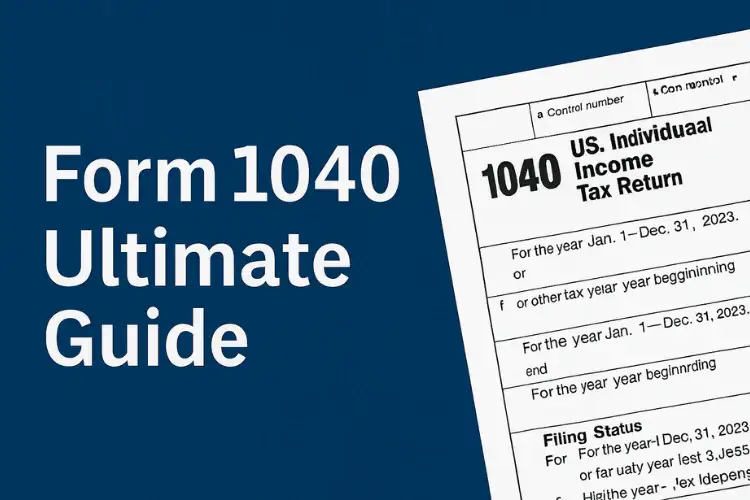Form 1040: Ultimate 2025 Guide for Filing Your IRS Tax Return
Filing your taxes isn’t exactly the highlight of the year. But understanding Form 1040 — the backbone of the U.S. individual income tax system — can save you serious money, stress, and possibly an IRS letter down the road.
Whether you’re a first-time filer, a retiree wondering about 1040-SR, or a side hustler tracking dozens of 1099s, this comprehensive guide will break it all down for you.

✍️ Quick Snapshot: What You’ll Learn
✅ What exactly is Form 1040 and why does it matter?
✅ Who must file Form 1040 (hint: more people than you think)
✅ The difference between Form 1040, 1040-SR, and the old 1040EZ
✅ How to file your IRS Form 1040 online, step by step
✅ Common mistakes people make on Form 1040 (and how to dodge them)
✅ How to amend a return if you made a mistake
✅ Smart tips to make next year’s Form 1040 a breeze
What Exactly Is Form 1040?
Form 1040 is the primary IRS document used to report your annual income, claim deductions and credits, and calculate whether you owe additional tax or get a refund.
Basically, if the IRS were a novel, Form 1040 would be the main character. Nearly every American taxpayer uses some version of it.
Who Must File Form 1040?
Not everyone needs to file a tax return each year. But chances are good that if you’re reading this, you probably do.
You must file Form 1040 if:
Your gross income exceeds the IRS filing threshold for your status (for 2025, roughly $14,600 for single filers under 65).
You’re self-employed with net earnings over $400.
You owe special taxes, like self-employment tax, early IRA withdrawal penalties, or additional taxes on a dependent’s income.
You want to claim refundable credits like the Earned Income Tax Credit.
You received health savings distributions or advanced premium tax credits.
👉 Tip: If you’re on the fence, use the IRS “Do I Need to File?” tool, or reach out to a professional who provides Income Tax Preparation Services. It’s usually better to file than risk penalties later.
Form 1040 vs. 1040-SR vs. 1040EZ: What’s the Difference?
There are multiple “flavors” of the individual tax return form:
Form 1040: The standard form nearly everyone uses. It handles all types of income, credits, deductions, and special situations.
Form 1040-SR: Nearly identical to Form 1040 but tailored for taxpayers 65+. It uses larger print and includes a handy standard deduction chart on the form.
Form 1040EZ: Was discontinued after 2017. It used to be for very simple returns (single or joint filers with no dependents and minimal deductions). Now, everyone uses the simplified modern Form 1040 or the 1040-SR.

How to File IRS Form 1040 Online: A Step-by-Step Guide
Honestly, e-filing is the best choice for most taxpayers. It’s faster, generally more accurate, and you’ll likely get your refund sooner.
1️⃣ Gather Your Documents
Before you even open tax software or print out Form 1040, make sure you have:
W-2s from employers
1099s if you’re freelance or have investment income
Mortgage interest or property tax statements
Receipts for deductible expenses (medical bills, charitable donations)
Last year’s tax return for reference
Bank account routing and account numbers for direct deposit
2️⃣ Decide How to File
IRS Free File: Perfect if your income is under a certain threshold and your situation is straightforward.
Tax software: Programs like TurboTax or H&R Block handle complex scenarios and auto-fill previous data.
A local expert: For complex cases, hiring a tax preparer Santa Ana CA might save you more in deductions and penalties than it costs.
3️⃣ Complete Your Form 1040 Carefully
Fill in your income details line by line.
Claim all eligible adjustments to lower your Adjusted Gross Income (AGI).
Choose whether to take the standard deduction or itemize — the software can help you pick the larger benefit.
Don’t forget credits like the Child Tax Credit or Saver’s Credit.
Before you hit submit, take a final glance at your Form 1040. Make sure every field matches your documents — small slip-ups here can delay your refund by weeks.
4️⃣ Submit and Keep Copies
E-file for speed, or mail if you must. Either way, keep digital and paper copies of your completed Form 1040 for at least three years.

Common Mistakes on Form 1040 (And How to Avoid Them)
Many taxpayers rush through their Form 1040 and overlook boxes tied to healthcare coverage or retirement contributions, leading to unexpected IRS letters.
Other frequent errors include:
Typing the wrong Social Security number
Forgetting signatures
Incorrect bank info for direct deposit
Not attaching required schedules (like Schedule C for gig work)
Honestly, a 5-minute double-check can save weeks of hassle — or even an audit. Some opt for Affordable Tax Filing Santa Ana services just for that peace of mind.
How to Amend a Return with Form 1040-X
So you filed, and a month later you realize — oops, you forgot a 1099. Don’t panic. The IRS has a fix: Form 1040-X.
Use it to correct errors or claim overlooked credits.
Generally, you have three years from the original filing date.
Be patient: amended returns can take 16 weeks or more to process.
Looking Ahead: Make Next Year’s Form 1040 Even Easier
Planning ahead not only smooths next year’s Form 1040 process but also helps you maximize credits and deductions you might otherwise miss. A few smart moves:
Adjust your W-4 withholdings so you’re not hit with a surprise bill (or tying up your money with the IRS all year).
Keep a folder for deductible receipts — medical, property taxes, donations.
If you’re self-employed, pay quarterly estimates to dodge penalties.
And it’s never too early to look into Income Tax Deductions strategies or confirm your employer’s Form W-2 details.
Related Guides to Help You Even More
FAQ's - Frequently Asked Questions - Form 1040
It’s the main IRS document to report income, claim deductions, and figure your tax due or refund.
Most people earning above the IRS minimum threshold, those self-employed, or anyone needing to pay extra taxes must file Form 1040.
Yes — most taxpayers do. E-filing is secure, faster, and reduces math mistakes.
1040-SR is designed for seniors with larger print and built-in deduction charts, but otherwise very similar.
File a Form 1040-X within three years to amend errors and possibly recover extra refund money.